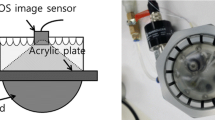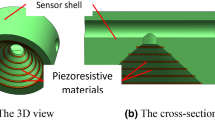Abstract
Tissue hardness is related to tissue composition, and this is often changed by disease. It is therefore of interest to measure the hardness in an objective and non-invasive way. A tactile sensor based on a vibrating piezoelectric ceramic element in a feedback loop is described. When the sensor touches an object it produces a frequency shift related to the hardness of the object. The aim of this study was to develop an in vitro hardness measurement method using a catheter type version of the sensor. The method was evaluated in an established silicone tissue model and on human prostate tissue in vitro. A linear relationship was found with a high degree of explanation (R2=0.98) between a cone penetration hardness standard (DIN ISO 2137) applied to the silicone model and the corresponding frequency shift. The results from measurements on a human prostate tissue sample, fixed with formalin, showed that the relative hardness measured with the tactile sensor correlated (R=−0.96, p<0.001, N=60) with the proposed hardness related to the histological composition of the prostate tissue. The results indicated that hardness of prostate tissue, and maybe hardness of human tissue in general, can be expressed according to the cone penetration standard and that the hardness can be measured with this tactile sensory system. These findings hold the promise of further development of a non-invasive tool for hardness measurement in a clinical situation.
Similar content being viewed by others
Abbreviations
- Z :
-
acoustic impedance of an object
- Z 0 :
-
acoustic impedance of the sensor element
- α:
-
acoustic resistance of an object
- β:
-
acoustic reactance of an object
- k :
-
stiffness related part of β
- m :
-
mass related part of β
- V 0 :
-
equivalent sound velocity in the sensor element
- PZT :
-
lead zirconate titanate
- CTS :
-
catheter tip tactile sensor
- Δf PZT :
-
frequency shift of PZT-element resonance
- Δf S :
-
frequency shift for sensor system resonance
- ϕ CTS :
-
phase shift over CTS
- Δϕ CTS :
-
change of phase shift over CTS
- F c :
-
contact force
- r :
-
radius of contact area
- r 0 :
-
radius of sensor half sphere tip
- l p :
-
penetration depth
- N :
-
number of observations
- Hardness :
-
consistency according to DIN ISO 2137
- Stiffness :
-
the ratioF c /l p for the sensor applied to an object (Omata andConstantinou, 1995)
References
Aarnink, R. G., Beerlage, H. P., de la Rosette, J. J. M. C. H., Debruyne, F. M. J., andWijkstra, H. (1998): ‘Transrectal ultrasound of the prostate: Innovations and future applications’J. Urol.,159, pp. 1568–1579
Floyd, T. L. (1988): ‘Electronic devices’ (Merrill Publishing Company, Columbus, OH)
Hodge, K. K., McNeal, J. E., Terris, M. K., andStarney, T. A. (1989): ‘Random systematic versus directed ultrasound guided transrectal core biopsies of the prostate.’J. Urol.,142, pp. 71–74
Kleinbaum, D. G., Kupper, L. L., Muller, K. E., andNizam, A. (1998): ‘Applied regression analysis and other multivariate methods’ (Duxbury Press, Pacific Grove, CA)
Lindahl, O. A., andOmata, S. (1995): ‘Impression technique for the assessment of oedema—comparison with a new tactile sensor that measures physical properties of skin’,Med. Biol. Eng. Comput.,33, pp. 27–32
Lindahl, O. A., Omata, S., andÄngquist, K.-A. (1998): ‘A tactile sensor for detection of physical properties of human skinin vivo’,J. Med. Eng. Technol.,22, pp. 147–153
Miyagi, K., Furuse, A., Nakajima, J., Kohno, T., Ohtsuka, T., Yagyu, K., Oka, T., andOmata, S. (1997): ‘the stiffness of lymph nodes containing lung carcinoma metastases: a new diagnostic parameter measured by a tactile sensor,’Cancer,80, pp. 1920–1925
Omata, S., andTerunuma, Y. (1991): ‘Measurement of skin elasticity using new type tactile sensor and its application to acupuncture therapy,’ Proceedings of 3rd USA-China-Japan Conference on Biomechanics, August 25–29, Georgia Institute of Technology, Atlanta, Georgia, pp. 153–154
Omata, S., andTerunuma, Y. (1992): ‘New tactile sensor like the human hand and its applications’,Sensors Actuators A,35, pp. 9–15
Omata, S., andConstantinou, C. E. (1995): ‘Modeling of micturition characteristics based on prostatic stiffness modulation induced using hormones and adrenergic antagonist’,IEEE Trans. Biomed. Eng.,42, pp. 843–848
Tobocman, W., Resnick, M. I., andPretlow, T. G. (1997): ‘Ultrasound reflection fail to reflect the histopathology of the prostate’,Prostate,30, pp. 33–40
USPublic Health Service National Institutes of Health (1993): ‘What you need to know about prostate cancer’, US-DEPT-HHS-PUBL, #NIH 93-1576 rev. ed.
Watanabe, T., Omata, S., Lee, J. Z., andConstantinou, C. E. (1997): ‘Comparative analysis of bladder wall compliance based on cystometry and biosensor measurements during the micturition cycle of the rat,’Neurol. Urodynam.,16, pp. 567–581
Weibel, E. R. (1979): ‘Stereological methods’, Vol. 1 (Academic Press, London)
Author information
Authors and Affiliations
Corresponding author
Rights and permissions
About this article
Cite this article
Eklund, A., Bergh, A. & Lindahl, O.A. A catheter tactile sensor for measuring hardness of soft tissue: measurement in a silicone model and in anin vitro human prostate model. Med. Biol. Eng. Comput. 37, 618–624 (1999). https://doi.org/10.1007/BF02513357
Received:
Accepted:
Issue Date:
DOI: https://doi.org/10.1007/BF02513357




